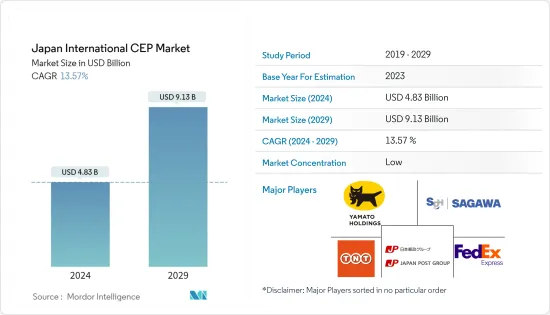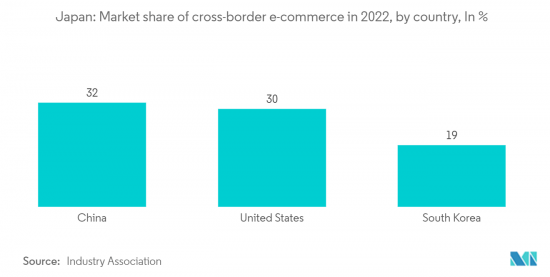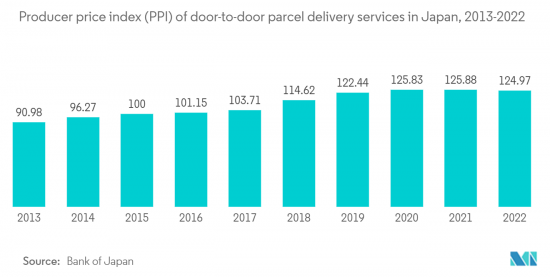 |
市場調査レポート
商品コード
1430606
日本の国際CEP - 市場シェア分析、産業動向と統計、成長予測(2024年~2029年)Japan International CEP - Market Share Analysis, Industry Trends & Statistics, Growth Forecasts (2024 - 2029) |
||||||
● お客様のご希望に応じて、既存データの加工や未掲載情報(例:国別セグメント)の追加などの対応が可能です。 詳細はお問い合わせください。
| 日本の国際CEP - 市場シェア分析、産業動向と統計、成長予測(2024年~2029年) |
|
出版日: 2024年02月15日
発行: Mordor Intelligence
ページ情報: 英文 120 Pages
納期: 2~3営業日
|
- 全表示
- 概要
- 目次
日本の国際CEP市場規模は2024年に48億3,000万米ドルと推定され、2029年には91億3,000万米ドルに達すると予測され、予測期間(2024年~2029年)のCAGRは13.57%で成長します。

日本は米国にとって主要な貿易・投資パートナーです。電子機器と自動車は日本の2大輸出品です。他国との貿易も日本経済にとって非常に重要です。
主なハイライト
- 2022年の日本の輸出品目は、自動車(886億米ドル)、集積回路(360億米ドル)、自動車;部品・付属品(8701および8705)(334億米ドル)、個別機能を有する機械(220億米ドル)、写真用ラボ機器(185億米ドル)などです。
- 国際貿易を促進するため、経済特区(SEZ)や自由貿易区(FTZ)が設けられ、宅配便・エクスプレス・小包会社(CEP)の収益創出を促進しています。
- 国際CEP市場の主な促進要因はeコマース部門です。日本は世界最大のオンライン・ショッピング市場であり、日本のeコマース市場はB2B取引が中心で、B2C販売に重点が置かれつつあり、C2C市場も台頭しつつあります。B2Cの売上は過去10年間で2倍以上に増加しました。
- 日本のインターネット普及率は2023年初頭には82.9%で、1億250万人がインターネットを利用しています。2023年1月には、日本で9,200万人がソーシャルメディアを利用しており、人口の74.4%を占めています。
- 2022年11月、日本は宇宙を利用した宅配サービスを開始します。東京に本社を置く株式会社アイスペースは、今月末に月面着陸船を打ち上げる予定であり、2台のローバーを含む商業用および政府用の多くの荷物を搭載する予定です。
日本の国際CEP市場動向
越境eコマースの成長が市場を牽引
日本の国際eコマースは増加傾向にあり、PPROの調査によると、日本の買い物客のeコマース利用先は中国がトップでした。米国は2位で、世界のeコマース売上の30%を占めています。米国と中国は日本製品にとって最大の市場です。経済産業省によると、2021年の中国向けオンライン売上高は前年比10%増の2兆1,300億円(143億7,000万米ドル)に達し、米国向けオンライン売上高は26%増の1兆2,200億円(840億米ドル)だった。20万円(1,370.99米ドル)のオンライン取引を除けば、この2カ国を合わせた輸出額は日本の年間総輸出額の約10%を占めました。
日本は、最も急速に成長しているeコマース・Mコマース市場の1つであり、デジタルに精通した人々が国境を越えて購入するようになっています。越境EC事業者にとって理想的な市場です。越境EC企業は、真正かつ正しい言語翻訳、ウェブサイトのアーキテクチャ、商品リスト、優れたカスタマーサービスなど、顧客体験をローカライズすれば、この市場で成功すると思われます。

日本における宅配便出荷量の増加
日本では、2022年の小包・包装貨物の取扱量は91億個に達し、前年の92億個に比べ1.1%減少しました。これは1秒当たり平均289個、1日当たり2,500万個に相当します。2022年に小包から生み出された総収入は270億米ドルで、前年比17%増となったが、小包1個あたりの収入は-16%減少しました。1人当たりの平均宅配便取扱個数は73個で、1世帯当たりの平均宅配便取扱個数は173個にとどまった。2022年には、2人以上の日本の世帯の半数近く(48.2%)がeコマースを通じて商品やサービスを購入し、過去10年間で過去最高となった。eコマース利用世帯数は近年着実に増加しており、レジャー関連の商品やサービスが最も人気のあるオンライン購入のひとつとなっています。

日本国際CEP産業の概要
日本の国際CEP市場は断片化されており、世界企業と地元企業が混在し、競争が激しいです。有力なプレーヤーには、ヤマト、佐川急便、TNTエクスプレス、日本郵便、フェデックスなどがあります。スマート・ロジスティクス・ソリューションの世界的プロバイダーであるギークプラスは、日本におけるナイキの即日配達を実現し、中国にあるナイキの新配送センターに高度なロボティクス・ソリューションを提供し、同社の「Goods-to-Person」シリーズから200台以上のロボットを導入したと発表しました。このスマートロボットは、ナイキの製品や荷物を倉庫作業員まで直接運び、コストを削減し、ピッキング効率を高め、倉庫作業員の日々の作業を楽にします。2022年、日本郵便は小包・包装貨物の市場シェアで最高(46%)を占め、ヤマトは最低(34%)です。
その他の特典:
- エクセル形式の市場予測(ME)シート
- 3ヶ月間のアナリストサポート
目次
第1章 イントロダクション
- 調査の前提条件と市場定義
- 調査範囲
第2章 調査手法
- 分析手法
- 調査フェーズ
第3章 エグゼクティブサマリー
第4章 市場洞察
- 現在の市場シナリオ
- 技術動向
- 政府規制
- 日本の物流・倉庫市場の概要
- 日本におけるクロスボーダー輸送
- 日本の貨物輸送市場の概要
- 日本のeコマース分野の注目点(国内および越境eコマースの解説)
- CEP市場へのCOVID-19の影響(市場と経済への短期的・長期的影響)
第5章 市場力学
- 市場促進要因
- eコマースの成長が市場を牽引
- 航空貨物の増加による市場の活性化
- 市場抑制要因
- 宅配便配送業務の可視性の低さ
- 市場機会
- 技術の進歩:高度な追跡システムのイントロダクション
- ポーターのファイブフォース分析
- 供給企業の交渉力
- 買い手の交渉力
- 新規参入業者の脅威
- 代替品の脅威
- 競争企業間の敵対関係の強さ
- サプライチェーン/バリューチェーン分析
第6章 市場セグメンテーション
- 事業別
- 企業間取引(B2B)
- 企業対顧客(B2C)
- 顧客間取引(C2C)
- タイプ別
- eコマース
- eコマース以外
- エンドユーザー別
- サービス
- 卸売・小売
- ヘルスケア
- 製造業
- その他のエンドユーザー
第7章 競合情勢
- 企業プロファイル
- YAMATO HOLDINGS CO. LTD
- Sagawa Express Co. Ltd
- TNT Holdings BV
- JAPAN POST Co. Ltd
- FedEx
- DHL
- Seino Transportation Co. Ltd
- United Parcel Service of America Inc.
- DB Schenker
- Nippon Express Co. Ltd
- Takuhai
- Agility
- KERRY LOGISTICS NETWORK LIMITED
- National Air Cargo Inc.*
第8章 市場の将来
第9章 付録
The Japan International CEP Market size is estimated at USD 4.83 billion in 2024, and is expected to reach USD 9.13 billion by 2029, growing at a CAGR of 13.57% during the forecast period (2024-2029).

Japan is a major trading and investing partner for the United States. Electronic equipment and cars are two of Japan's biggest exports. Trade with other countries is also very important for Japan's economy.
Key Highlights
- In 2022, Japan's exports are Cars (USD 88.6 billion), Integrated circuits (USD 36 billion), Motor vehicles; parts & accessories (8701 and 8705) (USD 33.4 billion), Machinery having individual functions (USD 22 billion) and Photo lab equipment (USD 18.5 billion) among others.
- To facilitate international commerce, Trade Special Economic Zones (SEZ) and Free Trade Zones (FTZ) are established, which facilitate the revenue generation of the Courier, Express, and Parcel companies (CEP).
- The main driving factor for the International CEP market is the E-commerce Sector. Japan is the world's largest online shopping market, Japan's e-commerce market is dominated by B2B transactions, with a growing emphasis on B2C sales and an emerging C2C market. B2C sales have more than doubled over the past decade.
- Japan's internet penetration rate was 82.9% at the beginning of 2023, with 102.5 million people using the internet. In January 2023, 92.00 million people in Japan were using social media, making up 74.4% of the population.
- In November 2022, Japan is launching a space-based courier service. ISpace Inc. the company, based in Tokyo, is planning to launch a moon lander later this month that will be carrying a bunch of commercial and government stuff, including two rovers.
Japan International CEP Market Trends
Growth in Cross Border E-commerce is driving the market
Japan's international e-commerce is on the rise, a study by PPRO found that China was the top e-commerce destination for Japanese shoppers. The US came in second with 30% of the global e-commerce sales. The United States and China are the country's largest markets for Japanese goods. In 2021, online sales to China reached JPY 2.13 trillion (USD 14.37 billion), a 10% increase from the previous year, while online sales to the United States increased by 26% to JPY 1.22 trillion (USD 84 billion), according to the Ministry of Economics, Trade and Industry (METI). The two countries combined accounted for about 10% of Japan's total exports for the year, excluding online transactions of JPY 200,000 (USD 1370.99).
Japan is one of the fastest-growing e-commerce & m-commerce markets with a digitally savvy population that is increasingly buying across borders. It is an ideal market for cross-border e-commerce businesses. Cross-border e-commerce companies will be successful in this market if they localize the customer experience, including genuine and correct language translations, website architecture, product listing, and superior customer service.

Increase in Volume of Parcel Shipments in Japan
In Japan, the volume of parcels and packets generated in 2022 reached 9,1 billion, a decrease of -1,1% compared to the previous year's 9,2 billion parcels. This represents an average of 289 parcels per second, equivalent to 25 million parcels per day. The total revenue generated from parcels in 2022 was USD 27 billion, an increase of 17% year-on-year, however, the revenue per parcel decreased by -16%, largely due to the strong US Dollar-Yen exchange rate in 2022. The average parcel generated per person was 73, while the average parcel generated per household remained at 173. Nearly half of Japanese households (48.2%) with 2 or more people purchased goods or services through e-commerce in 2022, a record high in the last decade. The number of e-commerce-using households has been steadily rising in recent years, and leisure-related products and services are among the most popular online purchases.

Japan International CEP Industry Overview
The Japanese international CEP market is fragmented, with a mix of global and local players, making it highly competitive. Some of the strong players include Yamato, Sagawa Express, TNT Express, Japan Post, and FedEx. Geek+, a global provider of smart logistics solutions, announced that it had powered same-day delivery for Nike in Japan, providing advanced robotics solutions to Nike's new distribution center in China and deploying more than 200 robots from its goods-to-person P series line. The smart robots carry Nike products and packages directly to the warehouse worker, reducing costs, increasing picking efficiency, and making daily work easier on the warehouse operators. In 2022, Japan Post has the highest market share (46%) for parcels and packets, while Yamato has the lowest market share (34%).
Additional Benefits:
- The market estimate (ME) sheet in Excel format
- 3 months of analyst support
TABLE OF CONTENTS
1 INTRODUCTION
- 1.1 Study Assumptions and Market Definition
- 1.2 Scope of the Study
2 RESEARCH METHODOLOGY
- 2.1 Analysis Methodology
- 2.2 Research Phases
3 EXECUTIVE SUMMARY
4 MARKET INSIGHTS
- 4.1 Current Market Scenario
- 4.2 Technological Trends
- 4.3 Government Regulations
- 4.4 Overview of the Logistics and Warehousing Market in Japan
- 4.5 Spotlight on Cross-Border Transportation in Japan
- 4.6 Brief on Japan Freight Forwarding Market
- 4.7 Spotlight on Japan E-commerce Sector (Commentary on Domestic and Cross-border E-commerce)
- 4.8 Impact of COVID-19 on the CEP Market (Short-term and Long-term Impact on the Market and on the Economy)
5 MARKET DYNAMICS
- 5.1 Market Drivers
- 5.1.1 Growth in E-commerce is driving the market
- 5.1.2 The market is fueled by the growing number of Air Freights
- 5.2 Market Restraints
- 5.2.1 Poor Visibility on the Courier Delivery Operations
- 5.3 Market Opportunities
- 5.3.1 Advancements in Technology: Introduction of Advanced tracking Systems
- 5.4 Porter's Five Forces Analysis
- 5.4.1 Bargaining Power of Suppliers
- 5.4.2 Bargaining Power of Buyers
- 5.4.3 Threat of New Entrants
- 5.4.4 Threat of Substitutes
- 5.4.5 Intensity of Competitive Rivalry
- 5.5 Supply Chain/Value Chain Analysis
6 MARKET SEGMENTATION
- 6.1 By Business
- 6.1.1 Business-to-Business (B2B)
- 6.1.2 Business-to-Customer (B2C)
- 6.1.3 Customer-to-Customer (C2C)
- 6.2 By Type
- 6.2.1 E-commerce
- 6.2.2 Non-e-commerce
- 6.3 By End User
- 6.3.1 Services
- 6.3.2 Wholesale and Retail Trade
- 6.3.3 Healthcare
- 6.3.4 Industrial Manufacturing
- 6.3.5 Other End Users
7 COMPETITIVE LANDSCAPE
- 7.1 Overview (Market Concentration and Major Players)
- 7.2 Company Profiles
- 7.2.1 YAMATO HOLDINGS CO. LTD
- 7.2.2 Sagawa Express Co. Ltd
- 7.2.3 TNT Holdings BV
- 7.2.4 JAPAN POST Co. Ltd
- 7.2.5 FedEx
- 7.2.6 DHL
- 7.2.7 Seino Transportation Co. Ltd
- 7.2.8 United Parcel Service of America Inc.
- 7.2.9 DB Schenker
- 7.2.10 Nippon Express Co. Ltd
- 7.2.11 Takuhai
- 7.2.12 Agility
- 7.2.13 KERRY LOGISTICS NETWORK LIMITED
- 7.2.14 National Air Cargo Inc.*
